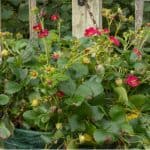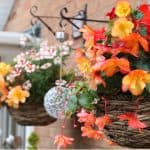Last updated on April 7th, 2022
Our site is reader supported, this means we may earn a small commission from Amazon and other affiliates when you buy through links on our site.
Hanging baskets are a wonderful way to take advantage of a small space. They work well for people who only have small porches or balconies without a large garden, people who live on a sloped hill and have uneven terrain in which to garden, or people who simply want to make the most out of all the available space in their garden.
Benefits of growing in hanging baskets
- The first benefit to growing in a hanging basket is, of course, making use of all available space. You might want stunning floral displays for your border gardens or in your containers around the balcony but you still want to have space for a seating area. In these situations, you can grow hanging baskets with your fruits and vegetables so that they are easily within reach, without taking up too much space.
- The second benefit is fewer pests. Most of the pest problems you have with fruit and vegetables are pests that come up from the ground. They might be insects that crawl their way onto your plants and eat the produce before you have a chance to harvest or ground moving animals that do the same. When you grow your fruit and vegetables in a hanging basket you don’t have this problem.
- Similarly, hanging baskets afford significantly higher levels of air circulation because things like strawberries, for example, grow out of the basket and trail downwards where the air flows all around them rather than sit atop the soil and overgrow in a crowded or limited space. This better air circulation means fewer chances of diseases and fungal growth that many fruit and vegetable plants are susceptible to.
- Easy harvesting is another benefit. It’s much easier to walk over to a basket that is standing at eye-level and pick available fruit than it is to get down on your hands and knees in a garden bed and rifle through leaves to find the hidden fruit when you’re in the middle of cooking.
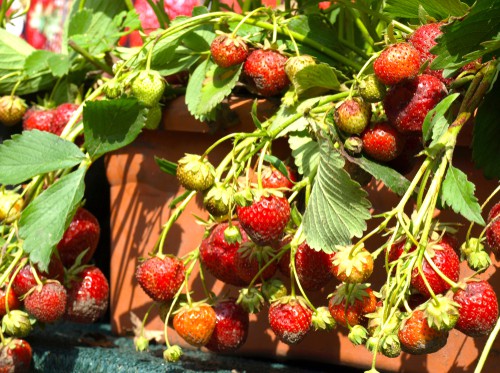
Tips:
Choose a large enough basket, in general, the bigger the better
Find the right basket size. The size of the basket will determine how many plants you can grow in one space. You also need to make sure you have the right hardware. Larger baskets can be quite heavy when they are full of soil, water, and plants. So make sure you have structures that can support the weight of the hanging baskets so they don’t fall down and that you secure the hanging basket brackets properly.
When it comes to the soil, be mindful of what you are growing and what they demand. Certain fruits and vegetables require highly acidic soil so you would need ericaceous compost, others prefer alkaline soil so a good quality potting compost would be ideal. Larger hanging baskets can often support multiple plants but you need to make sure that the multiple plants you choose prefer the same environments, otherwise, you’ll have them fighting in the soil.
- ERICACEOUS COMPOST - This specialist complete Ericaceous Compost has been blended to provide the right acidic soil conditions needed for optimum growth for your acid loving (lime hating) plants.
- COMPOST - Specifically designed compost for plants like Rhododendrons, Azaleas, Camellias, Heathers, Magnolias, Blueberries and similar acid loving shrubs.
- POTTING COMPOST - This amazing product is a general purpose compost, making it perfect to use for potting on or taking cuttings. Contains 20% Forest Gold wood fibre which opens the structure up.
- PLANT FERTILISER - Also includes starter fertiliser and some slow release plant feed, so no need to feed your plants for 10-12 weeks after potting.
- DETAILS - Supplied as a 60L bag with a weight of 16kg this soil will be big enough to fill a small bedding area or a large pot. Delivered direct to your door for ultimate convenience.
- Grows Plants Twice as Big
- Contains smart release feed granules for a season long feed
- Can be used in beds, borders, hanging baskets, pots and containers
Choose the right position
Look out for enough sunlight. Finding the right place to hang your basket is going to weigh heavily, no pun intended, on the plants you are growing. Things like tomatoes, peppers and strawberries need a lot of sun so you’ll need to find a location to hang the basket that gets between 8 and 12 hours of sunlight every day.
Water regularly
Hanging baskets are going to be home to thirsty occupants so you need to make sure you water them regularly. This type of watering is more time-consuming because you have to add a bit more than you normally would to compensate for the water that simply drains out of the soil and basket.
The Best Fruits and Vegetables to Grow

Strawberries and tomatoes
As mentioned, strawberries are wonderful plants to grow in a hanging basket. The fruit you get will tumble over the edge below the foliage allowing you easy access to the crops. In terms of vegetables, tomatoes work very well and there are plenty of varieties that are bred specifically for hanging baskets, one of which is called the ‘Tumbler’, and this is probably the best variety if you want a cherry tomato. Putting between 1 and 3 plants per basket is perfect and the vines will simply trail down the sides of the basket giving you better access to the produce.
Radishes, carrots, peas and beans
You can also grow stump-rooted varieties of summer radishes and carrots, combined with small beats or even lettuce. Peas and beans are great vegetables to grow in hanging baskets because of how easily they trail downwards.
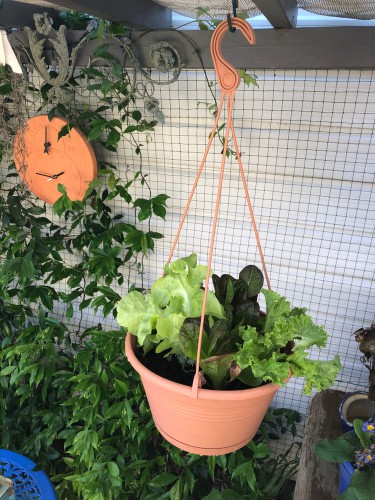
Try miniature cucumbers with peppers or chillis
Cucumbers are another option for hanging baskets and they can be mixed and matched with things like beans or chillis. Peppers and different chilli peppers can be combined in multiple containers with the herbs that you would use for your normal recipes. For example, you can grow cilantro or coriander around your hot chilli peppers with your tomatoes, meaning you always have the ingredients to hand that will you need for quick salsa.
Almost any herb will grow well in a hanging basket
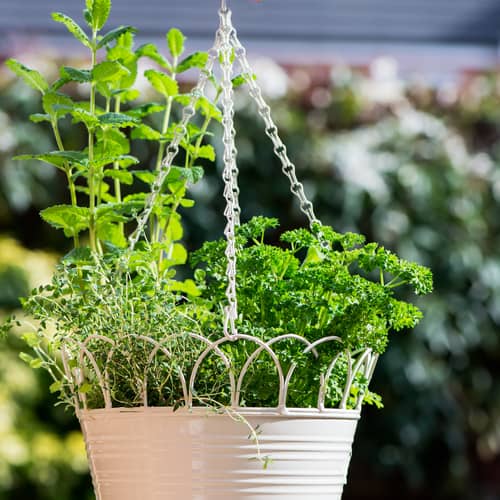
And of course, herbs are wonderful as well. Almost any herb can be grown and you can have one basket that is explicitly herbs, with plants like oregano trailing downwards, thyme flowing over the other side, and some basil growing upright in the middle.
Planting
The planting process is exactly the same as in the ground or in a container. You want to add things like compost and slow-release fertiliser depending on what you are growing into your potting mixture. Move aside a hole into which you place your plants and then cover them with the remaining soil. All of the soil should be watered thoroughly before and after planting.
- Feeds plants for up to 6 months, removing the needs for regular feeding
- Temperature controlled coating releases nutrients only when conditions are right for feeding
- Ideal for all types of plants and suitable for fruit and vegetables
- Ideal for beds, borders, pots, containers and hanging baskets
- Feeds up to 40 plants
If you are using a type of plastic liner to hold in all of the compost in your hanging basket be sure to punch some extra holes (or cut some slits along the sides) to help with drainage and air circulation. You can buy plenty of hanging baskets that are designed specifically for fruits and vegetables that have all of the components included or you can mix and match styles by bringing your own hardware to an existing basket.
Care
Regular maintenance and care are the same as it would be for the fruits and vegetables if were you to plant them in the ground or in a container. Depending on what you are planting you will need to add things like fertiliser, different levels of water, pruning, or toppings for herbs like basil.
Some of these items can be protected over winter by cutting them back and either placing the basket in the ground where they’re protected, moving them inside, or storing them in an area where they are protected from heavy wind and rain and wrapped with something like horticultural fleece.
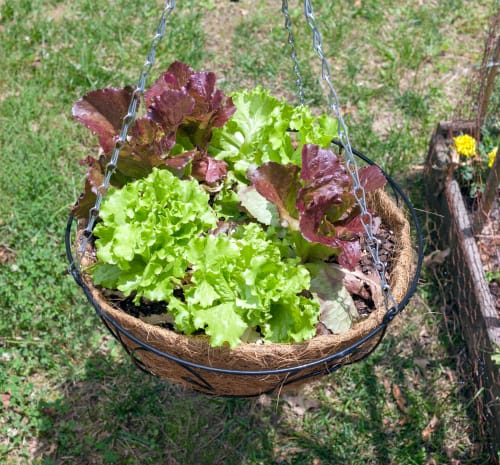
Other plants like herbs might be better off brought inside in a warm room with a windowsill so that you can continue to trim away the herbs as you cook throughout the winter, while things like peppers are better replaced every year so that you can get optimum crops.
Related articles you may be interested in
Growing tomatoes in hanging baskets
Try something different – planting tomatoes in upside-down hanging baskets
Image credits – Shutterstock.com
Last update on 2025-07-09 / Affiliate links / Images from Amazon Product Advertising API




